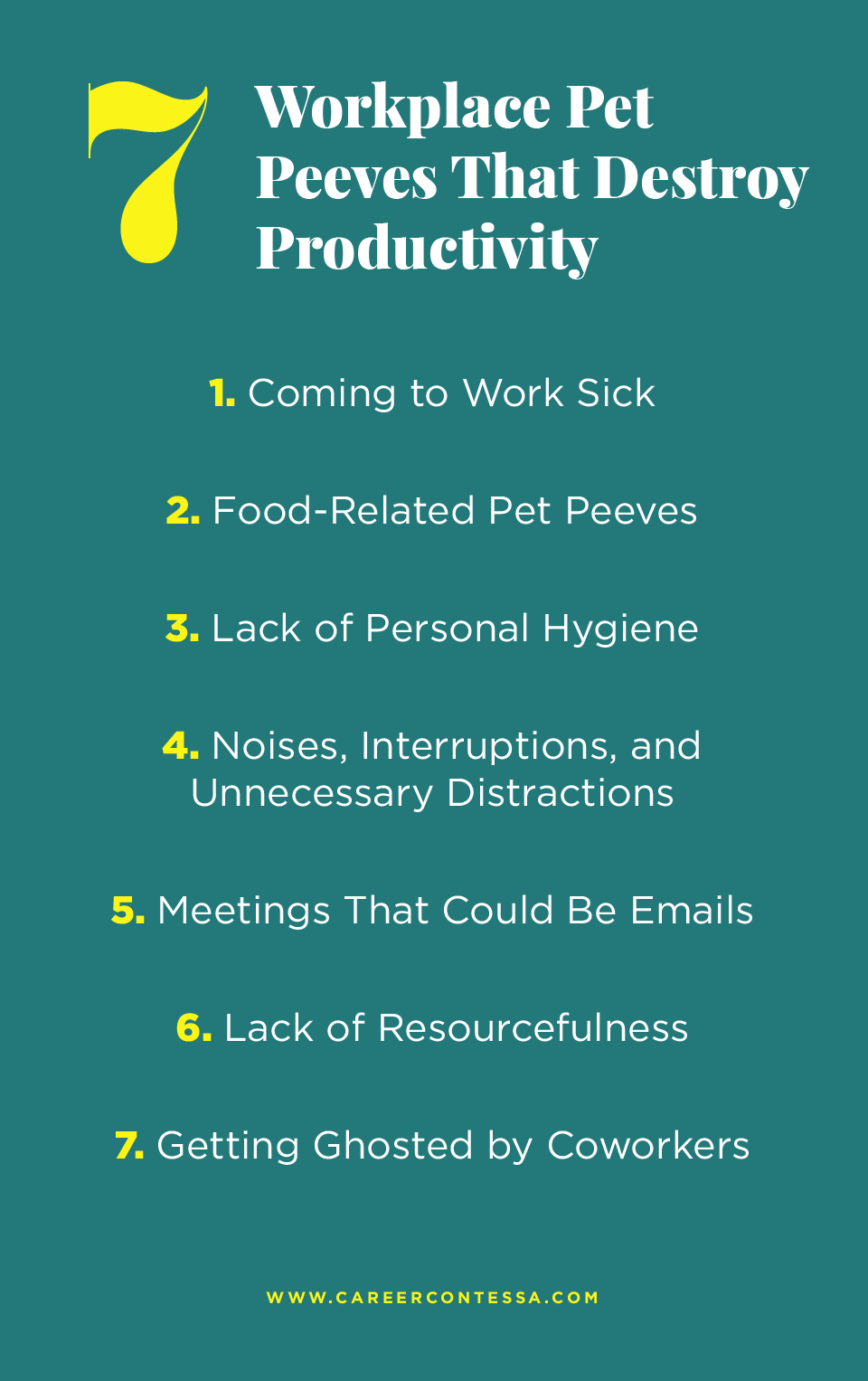The nonstop pen-clicking. The smell of microwaved fish. The constant interruptions. What do all of these things have in common?
They're workplace pet peeves, and they drive you nuts. You experience them in the office and virtually, and they derail your day and decrease your productivity.
What are Workplace Pet Peeves?
Pet peeves, defined as frequent subjects of complaint, are those things, both little and big, that are aggravating and hinder you from doing your job well.
It could be because
they're distracting, they prevent you from moving a project forward, or they make your work environment less than ideal. Simply put, workplace pet peeves are annoying. They disturb your day, reduce your productivity, and make you absolutely bonkers.
If I were to ask you to name your biggest pet peeve at work, I bet you'd have a hard time picking just one. At the risk of sounding cliché, my biggest pet peeve is a
meeting that could be an email—followed closely by unanswered emails, dirty common spaces, and continuous coughing when you're sick and should have just stayed home. See what I mean? It's hard to name only one.
Common In-Office Pet Peeves (+ How to Deal)
While we could rant all day about pet peeve examples and how they destroy our productivity, complaining won't
solve the problem. So how can we deal with those workplace annoyances that are out of our control?
I have a few common pet peeves and a few accompanying ideas on how to handle them.
"Studies have shown that it takes an average of around 25 minutes to refocus on a task after an interruption."
Coming to Work Sick
With the state of the world right now, this pet peeve runs high on the list. When a coworker comes into the office with a cold or something worse, they're showing a blatant disregard for their coworkers' health. It's rude, and if
everyone gets sick, nothing will get accomplished.
How to Deal:
If your company offers the opportunity to work from home, kindly suggest your coworker do so. If you don't feel comfortable directly approaching your coworker, speak to your boss about your concerns. They could potentially have a conversation with the employee or the employee's manager to
address the issue. If they won't work from home, see if you can.
If
working from home is out of the question, explore working from a different location in the office until your coworker is healthy. Try a conference room or another desk, if they're available.
Food-Related Pet Peeves
When doing research for this article, I took to Instagram to ask people to tell me their biggest pet peeves. Overwhelmingly, a common theme was food.
The list ranged from coworkers eating smelly food at their desk, people hogging the microwave when heating their lunch, and dirty kitchens where people prepare and store their food. While these pet peeves don't directly impact you from getting work done, they can be distracting, and some are just downright gross.
How to Deal:
If someone chooses to eat something stinky in proximity to your desk, it's hard to tell them not to eat it (unless you have an allergy they should know about). Unfortunately, you may have to deal with this one.
Try taking a bathroom break while they eat, or coordinate your schedule so you don't have to be around when they're eating. You can politely mention to them that the scent is bothersome, but if that's what they brought to eat, it's not in your control to make them stop eating it.
I say this as someone who ate hard-boiled eggs at my desk while pregnant because it was the only thing that curbed my hunger. I'm sorry, it was gross, but I did it.
For the microwave hogs and those that don't clean up after themselves, see if you can put some rules in place for shared spaces in the office. If there's a flyer on the wall clearing stating you need to clean up after yourself (even if it is common sense), it may make it a little easier to have a conversation with coworkers when they don't.
Lack of Personal Hygiene
High on the list next to food-related pet peeves were personal hygiene items, including coworkers with a particularly unpleasant smell and those who take care of personal hygiene at work (think clipping their nails at their desk). If you're not comfortable in your workspace because someone is getting a little too comfortable in theirs, your productivity can be derailed.
How to Deal:
Personal hygiene can be a sensitive issue, especially if the person involved is entirely unaware of how they're perceived. If you're comfortable enough to be direct with your coworker, kindly pull them aside and express your concerns.
Your company may even have some policies in your employee handbook relating to personal care that you can leverage. If you don't want to
have the conversation yourself, speak to your manager or human resources. They'll be better equipped to approach the situation delicately.
Noises, Interruptions, and Unnecessary Distractions
With everyone coexisting in the same space for eight-plus hours a day, you're bound to encounter some noisy annoyances. Tapping on desks, coworkers just stopping by your desk to talk, people on the phone, and
coworkers chatting with each other are only a few of the pet peeves you're likely to encounter in most workplaces.
The interruptions lead to constant starting and stopping of work, which prolongs you from crossing tasks off
your to-do list.
How to Deal:
Headphones are a great way to drown out some of the noise. Pop them in and
turn on a playlist or white noise to keep you in the zone. If a coworker repeatedly drops by your desk to chit-chat, do your best to keep the conversation brief. You're all at work to do your job, so they shouldn't be offended if you tell them you can't talk long.
You can also try to block off your calendar or turn your status on your company's instant messaging platform to busy. If a coworker sees that before they leave their desk, they may be less likely to pop by unannounced.
Common Remote Pet Peeves (+ How to Deal)
Meetings That Could Be Emails
Everyone's favorite pet peeve is attending a meeting that could have easily been an email. It continues to be a topic of discussion because, like it or not, unnecessary meetings are bound to happen.
How to Deal:
First and foremost, we can do our best to only
hold meetings that are absolutely necessary (I know, easier said than done). If someone proposes a meeting, question the purpose and the value it will add to move work forward. You can even propose the conversation occur over email if you don’t think a meeting is needed.
If the inevitable happens, make sure you have a clearly defined agenda that outlines what you'll be discussing and what you're trying to accomplish. If you walk into a meeting without a clear objective, you'll likely walk out of it feeling like you've wasted your time.
Lack of Resourcefulness
Sometimes
coworkers lack common sense. This pet peeve sounds harsh, but hear me out. Have you ever been asked a question where the answer can be easily found through a quick Google search? Have you worked with a person who doesn't do the work and expects solutions to be handed to them?
What about the coworker who doesn't stop to think before clogging your inbox with an email asking a question they already have the answer to? These are all interruptions to your day that are absolutely unnecessary and could be avoided if they took a few moments to problem solve before reaching out.
How to Deal:
This is a prime coaching moment. Whether the person is your peer or your direct report, you can use this as an opportunity to teach them how to respond when they find themselves in a situation where they don't know the answer.
The first time they reach out with a question, if time is of the essence, you can give them the solution and then explain how they can find it themselves next time. Alternatively, you can point them in the right direction and have them do the research themselves. Sometimes people learn best by doing. If, after a few gentle nudges to use their knowledge to problem solve, they continue to reach out, it may be time for a
broader conversation about their performance.
Getting Ghosted by Coworkers
Ghosting isn't only a dating term. A common workplace pet peeve is when coworkers don't respond to emails, calls, and instant messages, or worse, don't show up to meetings where their input is needed. This is not only frustrating, but it holds up progress on projects and to-do list items.
How to Deal:
Be persistent and give your coworker the benefit of the doubt. If they didn't answer your email, send another or give them a call. If they didn't answer your call, try again and leave a voicemail. If they skipped a meeting, reach out to see if everything is OK before assuming they just didn't want to attend.
While waiting for responses from others can seriously deter progress and productivity, sometimes it’s unavoidable. If you've done everything in your power to get a response and it's still radio silence, reach out to someone else in their department or their manager to see if they can help.
How Workplace Pet Peeves Become Seriously Disruptive
Besides the obvious fact that pet peeves are irritating, they can also disrupt workflows, progress, and prohibit you from accomplishing tasks.
Many of the pet peeve examples above result in constant interruptions, and studies have shown that it takes an average of around 25 minutes to refocus on a task after an interruption. That means that every time someone stops by your desk, it's not just a five a minute interruption; it's a 30-minute one.
If your pet peeves aren't distracting you, they may be disrupting moving items forward on a project. If you're getting ghosted by a coworker or
productivity is plummeting from too many meetings, it's likely that deadlines won't get met, which is bothersome not only for you but for everyone involved.
The cherry on top is the fact that pet peeves can make you uncomfortable in your work environment. If you're not comfortable in your office or around your coworkers, you're not going to do your best work. It’s frustrating when things out of your control start to affect the quality of your work product, but focus on doing your best you can with what you can control.
How to Communicate Boundaries Upfront
The key to communicating boundaries upfront is just that—
communicating. You can't expect your coworkers to read your mind. If you don't express that something bothers you and affects your productivity, they may never know or change their behaviors.
Assume the best about people and try not to take it personally. They don't wake up thinking of ways to ruin your day (even if it feels that way).
When you start working with someone,
let them know how you work best and what you need to perform at your peak. This is especially crucial if you are a manager. Communicating boundaries with your team on day one sets the tone and ensures fewer bad habits to break down the road.
If being upfront with your words doesn't work,
lead by example. Show your coworkers how productive you can be when there are minimal distractions. Stay home from work when you're sick, so others feel comfortable doing the same.
Maybe don't cook smelly food if you can at all help it. Showing others how to foster a work environment that promotes productivity can change behaviors and establish a better overall team dynamic.
A Few More Common Workplace Pet Peeves (For Fun)
Here are a few workplace pet peeves that many people have. From what we gathered from the internet, people could be a little more sensitive to the gluten-free diet and celiac disease.
Most of these are specific to in-office environments—unless your own partner or roommate leaves the toilet seat up.
- Bad internet connection
- Office food
- Toilet seat being left up
- Facebook + other social media being blocked by a firewall
- Coworkers who wear shoes with no socks
- Lack of privacy in an open office
- Colleagues who never stop talking
- Jury duty
- Annoying coffee orders
- An unwanted "helpful observation" from a nosy coworker
- Nosy coworkers
- Important emails that aren't actually important
- The phrase, "I'm sorry you feel that way"
- Sharing public spaces
- Parking lot hijinx
- The coworker who calls beers "adult beverages"
- Meetings take up work time (and free time)
- Bodily noises or functions












